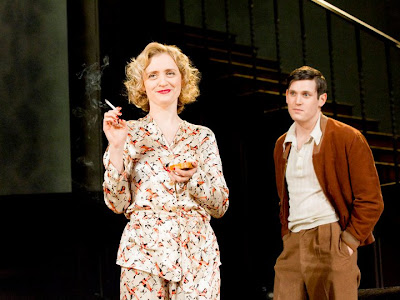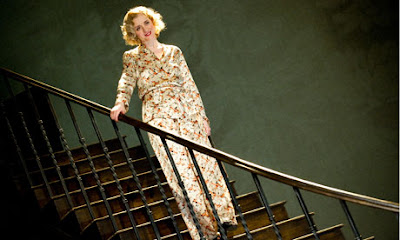 The Rattigan revival was kicked off last year by the huge success of Thea Sharrock's production of his little-remembered second play AFTER THE DANCE at the Lyttleton and here she is reunited with her stage designer from that production Hildegard Bechtler to work their magic again - and they do.
The Rattigan revival was kicked off last year by the huge success of Thea Sharrock's production of his little-remembered second play AFTER THE DANCE at the Lyttleton and here she is reunited with her stage designer from that production Hildegard Bechtler to work their magic again - and they do.Rattigan based his play on a 1935 murder trial that had haunted him. In 1934, in that febrile hothouse Bournemouth, 18 year old George Stoner answered an ad in
 the Daily Echo "Daily willing lad, 14-18, for house-work; Scout-trained preferred. Apply between 11-12, 8-9 at 5 Manor Road, Bournemouth". The ad was placed by retired architect Francis Rattenbury, 67 and his younger songwriter wife Alma, 39. Before long Alma and George were openly having an affair with Francis' tacit approval as he was not only impotent but a heavy drinker. Six months later, the police arrived in the early hours to find him with his head bashed in and Alma in a state of drunken hysteria.
the Daily Echo "Daily willing lad, 14-18, for house-work; Scout-trained preferred. Apply between 11-12, 8-9 at 5 Manor Road, Bournemouth". The ad was placed by retired architect Francis Rattenbury, 67 and his younger songwriter wife Alma, 39. Before long Alma and George were openly having an affair with Francis' tacit approval as he was not only impotent but a heavy drinker. Six months later, the police arrived in the early hours to find him with his head bashed in and Alma in a state of drunken hysteria.Alma and George were put on trial for murder in an atmosphere of lurid press headlines that played up the "experienced woman - innocent lad" angle. In a sensational outcome George was found guilty but Alma was found not guilty. A few days later Alma took a train to Christchurch near Bournemouth, found a spot near the River Avon and, believing her lover soon to hang, stabbed herself to death.
The irony was that after a petition of 320,000 signatures, his sentence was commuted to Life. However, in 1942 he was released on early parole, joined the army and fought in WWII, and was even reported to have been seen in the audience at Her Majesty's seeing his 18 year old self be seduced by Glynis Johns as Alma. He died in 2000 aged 83 on the 65th anniversary of the murder.
 Rather than retell the sad story as is, Rattigan seeks to spotlight the atmosphere of sexual hypocrisy that the case was rife with by contrasting Alma's trial with the fictional story of Edith Davenport, a sexually-frigid, emotionally-cold woman whose own marriage is collapsing due to her husband's small affairs and her puritanical attempts at keeping her teenage son with her and away from the temptations of the world. Out of the blue she is summoned for jury duty - and to her horror, is made foreman of Alma's jury.
Rather than retell the sad story as is, Rattigan seeks to spotlight the atmosphere of sexual hypocrisy that the case was rife with by contrasting Alma's trial with the fictional story of Edith Davenport, a sexually-frigid, emotionally-cold woman whose own marriage is collapsing due to her husband's small affairs and her puritanical attempts at keeping her teenage son with her and away from the temptations of the world. Out of the blue she is summoned for jury duty - and to her horror, is made foreman of Alma's jury.He neatly shows that while Mr. Davenport's dalliances for sexual gratification are seemingly understood and turned a blind-eye to by society, the same cannot be granted to Alma whose sexual frustration is seen as something abhorrent especially when her lover is a younger man, the poor boy preyed upon by a wicked woman. The fact of a woman being judged more for her morals rather than any perceived crime had been the case over ten years before with the tragic hanging of Edith Thompson and was certainly a factor twenty years later in the case of Ruth Ellis.
 Rattigan said he didn't have far to look for his inspiration for Edith as he based the emotionally-fraught scenes between her and her sexually curious son on the relationship between him and his mother. In a remarkably hard-edged performance, Niamh Cusack excelled as Edith, a woman who finds at the end of the play that the woman she despised but could not find guilty thanks to her own morality, could not live on because of her own morality.
Rattigan said he didn't have far to look for his inspiration for Edith as he based the emotionally-fraught scenes between her and her sexually curious son on the relationship between him and his mother. In a remarkably hard-edged performance, Niamh Cusack excelled as Edith, a woman who finds at the end of the play that the woman she despised but could not find guilty thanks to her own morality, could not live on because of her own morality.She was complemented well by Simon Chandler as her husband John, exhausted by years of living by her rules and Lucy Robinson as her more gregarious sister Stella, mad with excitement about the latest gossip from the jury room.
 Rattigan has great fun with the legal scenes in showing the court-room cat & mouse games between the defense and prosecuting councils are merely the public jousting to revenge losses between them on the golf courses. Nicholas Jones is a stand-out as T.J. O'Connor, Alma's wily Defence Council who gambles constantly with his handling of her case.
Rattigan has great fun with the legal scenes in showing the court-room cat & mouse games between the defense and prosecuting councils are merely the public jousting to revenge losses between them on the golf courses. Nicholas Jones is a stand-out as T.J. O'Connor, Alma's wily Defence Council who gambles constantly with his handling of her case.In a a role that only amounted to two bookend scenes, the consummate supporting actress Jenny Galloway still managed to shine as Alma's live-in companion Irene Riggs and Tommy McDonnell was a cocky and dangerous-to-know George in this, his professional stage debut. The echoes of AFTER THE DANCE were in the casting of Benedict Cumberbatch's father Timothy Carlton as the doomed Francis.
 But the show was rightly dominated by Anne-Marie Duff's high-voltage performance as Alma. First seen playing with the gauche George by adopting a stolen-from-the-movies divinely decadent lady of the manor demeanor, the play's structure of flashback scenes had her moving from bring strained and drawn in court to be blindly hysterical while blindly drunk to being finally a shattered woman, her declared innocence a hollow victory. She was mesmerising.
But the show was rightly dominated by Anne-Marie Duff's high-voltage performance as Alma. First seen playing with the gauche George by adopting a stolen-from-the-movies divinely decadent lady of the manor demeanor, the play's structure of flashback scenes had her moving from bring strained and drawn in court to be blindly hysterical while blindly drunk to being finally a shattered woman, her declared innocence a hollow victory. She was mesmerising.The play's strangely amorphous quality where scenes move from place to place, forwards and back in time, betray it's origins as a 1975 radio play which starred Diana Dors as Alma (wow!) - both Rattigan's radio script and an initial stage version were edited together by the director Robin Midgeley with the ailing Rattigan re-writing when necessary. Thea Sharrock however keeps a firm grip on the narrative and the play is helped immeasurably by Hildegard Bechtler's set which opens up the whole of the Old Vic stage with walls constantly moving between scenes to provide new vistas with several hugely effective uses of the stage's depth. Again these visually arresting scenes emerge from the shadowy gloom of Bruno Poet's dreamlike stage lighting.
 When Rattigan wrote his play he left out some intriguing facts about the case: Alma was actually Canadian, having met George in 1923 while he lived and worked there as an architect of some renown Alma's first husband was killed in the
When Rattigan wrote his play he left out some intriguing facts about the case: Alma was actually Canadian, having met George in 1923 while he lived and worked there as an architect of some renown Alma's first husband was killed in the  Battle of the Somme and she volunteered to be a nurse in the French Red Cross where she was wounded twice in action and was awarded the Croix de Guerre. Her second husband was a Pakenham so was distantly related to Lord Longford who later was such a supporter for the release of Myra Hindley.
Battle of the Somme and she volunteered to be a nurse in the French Red Cross where she was wounded twice in action and was awarded the Croix de Guerre. Her second husband was a Pakenham so was distantly related to Lord Longford who later was such a supporter for the release of Myra Hindley.When George's first wife refused him a divorce he harassed her mercilessly - stripping their home of furniture and turning off the power. He eventually moved Alma in
 and forced his wife to live on the first floor until she eventually agreed to a divorce and they were married in 1925. These actions were seen as in the Canadian newspapers as a shocking scandal. In 1929 they left Canada after his first wide died and his sons by that marriage disowned him. So his murder at the hands of Alma's lover 12 years later was headline news here and there.
and forced his wife to live on the first floor until she eventually agreed to a divorce and they were married in 1925. These actions were seen as in the Canadian newspapers as a shocking scandal. In 1929 they left Canada after his first wide died and his sons by that marriage disowned him. So his murder at the hands of Alma's lover 12 years later was headline news here and there.The Rattenbury's youngest son John was evacuated to Canada in WWII and eventually, following in his father's footsteps, became an architect and joined Frank Lloyd Wright's practice helping with the design of the Guggenheim Museum amongst others.
No comments:
Post a Comment